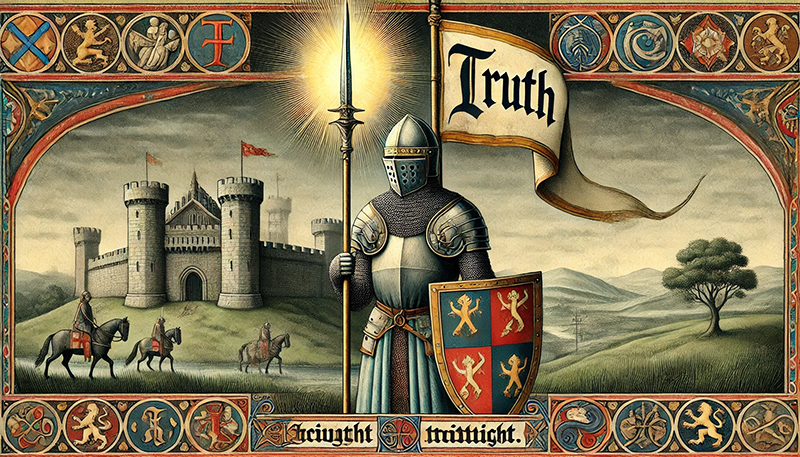The Book of the Order of Chivalry (c. 1275), was written by Ramon Llull (1232–1315), a polymath and Christian mystic from Majorca. Llull thought that knights should be chosen, trained, and ordained like priests. Llull’s book became a handbook of chivalry throughout much of Europe. Being a Christian mystic, of course he writes about Chivalry using Christian vocabulary. But I think his ideas transcend any particular Spiritual Tradition.
Llull wrote over 250 books on a wide range of subjects, including theology, philosophy, logic, science, and even poetry. (And one on Chivalry!) He is best known for his book Ars Magna — a groundbreaking philosophical and logical system that aimed to uncover universal truths using mathematics — now considered the invention of Mathematical Combinatorics. He was also known for his interest in memory and logical systems more generally: his method of linking virtues to physical objects is an example of the ancient memory technique known as the Memory Palace.
An overview of the Order of Chivalry, and a linked table of contents to all my blogs (with music) on various chapters of Llull’s book can be found HERE.

Here Llull equates the knight’s lance with ‘truth’:
The lance is given to the knight to signify the truth, for the truth is straight and does not bend, and truth goes before falsehood. And the lance-head signifies the power that the truth has over falsehood, and the pennant signifies that the truth reveals itself to all, and has no fear of falsehood or treachery. And truth is the support of hope, as it is of everything else that the knight’s lance signifies regarding the truth.
Llull’s use of the knight’s lance to symbolize truth reflects a universal principle that transcends any single spiritual tradition: the integrity and invincibility of truth in the face of falsehood. By equating the lance with truth, Llull emphasizes qualities that resonate across various philosophical and spiritual teachings—the unyielding, direct, and illuminating nature of truth.
“The truth is straight and does not bend.”
Here, the straightness of the lance represents the clarity and purity of truth. Across cultures, truth is often depicted as something that remains constant, irrespective of circumstances, unlike deceit or falsehood, which is flexible, manipulative, and inconsistent. Just as the lance is designed to cut through barriers, truth slices through illusion and deception, guiding individuals toward deeper understanding. This concept is echoed in many spiritual traditions, where truth is seen as the foundation of wisdom, integrity, and moral living.
“Truth goes before falsehood.”
Truth leads the way, always ahead of falsehood, because falsehood depends on the distortion or absence of truth. In Llull’s metaphor, truth is not reactive but proactive—it is a guiding force. In the larger spiritual context, this idea suggests that seeking truth is not merely a defense against lies but an active pursuit that shapes the world around us. Whether in Buddhism’s commitment to right understanding, the Islamic value of *haqq* (truth), or the ancient Greek *aletheia* (truth as revealing), the act of seeking and embodying truth is regarded as transformative and transcendent.
“The lance-head signifies the power that truth has over falsehood.”
The lance’s sharp tip reflects the penetrating power of truth. Truth is not passive; it has the ability to dismantle falsehood, just as a lance pierces through the defenses of an enemy. This symbolism speaks to the dynamic nature of truth in the world—truth confronts and corrects. Many spiritual paths, from the Daoist emphasis on harmony with the natural order to the Hindu concept of *satya* (truth) as a path to liberation, recognize truth as an active, powerful force that brings alignment with reality.
“The pennant signifies that the truth reveals itself to all, and has no fear of falsehood or treachery.”
Truth, like a pennant waving at the end of the lance, is visible and open. It does not hide, for there is no fear in truth. This openness contrasts with the secretive and deceptive nature of falsehood, which thrives in darkness. The idea of truth being revealed to all aligns with the mystical belief that truth is accessible to everyone, regardless of background or spiritual tradition. In the Christian Gospel, the Buddhist Dharma, the Jewish concept of *emet*, or the Sufi understanding of unveiling the divine truth, the common theme is that truth is something that shines and invites recognition—it is not esoteric but available to those who earnestly seek it.
“Truth is the support of hope.”
Lastly, Llull’s profound statement that “truth is the support of hope” underlines the essential role truth plays in grounding our aspirations. Hope is fragile without truth, for falsehood leads to disillusionment and despair. Truth, by contrast, provides a foundation on which hope can stand firmly, giving us a clear vision of what is real and attainable. This idea of truth sustaining hope is found in many traditions. In the Buddhist path, for instance, hope for liberation is rooted in the truth of suffering and its cessation. In Stoic philosophy, hope is grounded in understanding and accepting the truth of the world’s nature.
Across spiritual traditions, the truth is an eternal principle, guiding people toward ethical action, wisdom, and fulfillment. Llull’s image of the knight’s lance as a symbol of truth reminds us that, regardless of the language or symbolism of a particular tradition, truth remains an unshakable, unifying force that transcends boundaries, leading us toward deeper understanding, justice, and inner peace.



Leave a Reply